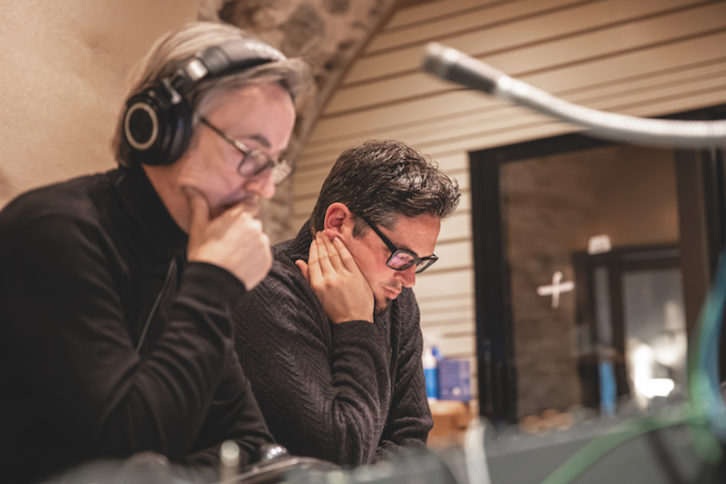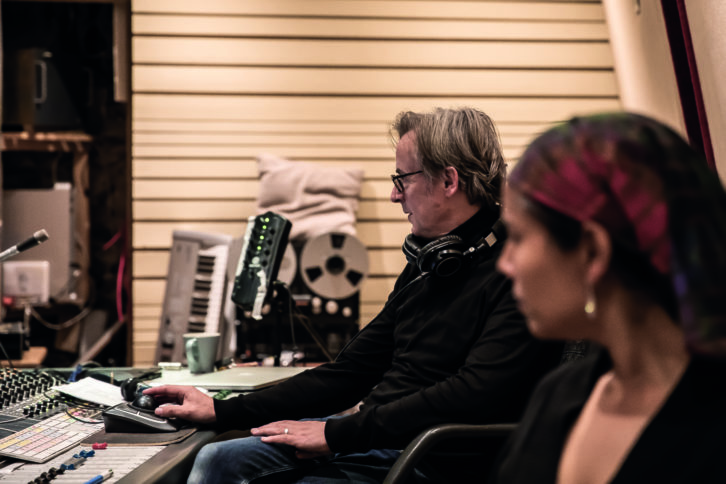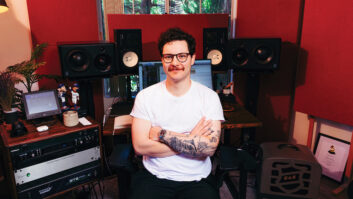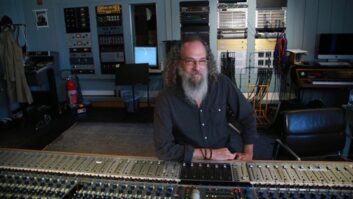
They’re Calling Me Home, the new release from former Carolina Chocolate Drops frontwoman Rhiannon Giddens and her partner, musician Francesco Turrisi, packs a soulful punch. Recorded while the couple were quarantining—actually stuck—in Dublin, Ireland, during the pandemic, the record echoes the artists’ childhood memories of Americana and Italian music, as well as the traditional tunes of their temporary home.
It is a raw but sublimely rich album, and for most of the recording process, the couple hunkered down in the studio with engineer Ben Rawlins, who had met Turrisi about 10 years ago and has worked with him frequently since.
“I met Francesco, a former student at the Royal Conservatory of the Hague, when he was in an early music group called the Gregory Walkers,” recalls Rawlins. “We started working together, and then he would get me in to record his various solo projects because I had a good feel for acoustic music and classical music.
“There was an idea for Francesco and Rhiannon to record an album of baroque musicians with me in April of last year,” he adds. “But some of those musicians were from Italy and Spain, and those places were absolutely having a terrible time with Covid. So that record got canceled. They also had plans to make a record in California, and that got canceled. But then they ended up stranded in Ireland last summer, and they contacted me to talk about laying down some folk songs that they had been playing to keep themselves from going crazy.
“Rhiannon was doing a lot of folk songs about North Carolina. Francesco was playing Italian lullabies. These were songs that reminded each of them of their homeland. Then we found this beautiful studio called Hellfire, on a working farm up in the mountains. It’s in a small, old stone barn, and we got lucky: We happened to go in there for six days during one week when there was no lockdown.”
Giddens and Turrisi had developed an album’s worth of beautiful, simple arrangements, playing every instrument themselves, so they arrived with every tool they might need.
“It was kind of hilarious because it took ages to load in,” Rawlins says. “It was instrument after instrument.”
FACE TO FACE IN THE STUDIO
In the studio, Rawlins set the pair so that they faced each other, with their instruments placed around them on the floor. Each needed several choices at hand so that they could switch easily.
“Rhiannon had her fretless banjo, her gourd banjo, as well as her fiddle, and she had gotten an octave viola made for her; it’s a big instrument—really rich-sounding, like a cello,” Rawlins explains. “Francesco had all his drums; he was also using a banjo that belonged to Mike Seeger—a cello-banjo that is about 100 years old.
“The idea was to have all of these very resonant instruments, as opposed to bright, steel-string banjos and bright fiddles. They wanted a darker tone. So I also brought along my own collection of microphones, which basically consists of a whole lot of tube microphones and a whole lot of ribbon microphones.
“There was no plan,” Rawlins explains further. “I wasn’t given a list of songs. It was often like they were just chatting, and then all of a sudden they’d just start playing an old song. I just had to put mics around them that would allow me to capture whatever they were playing. So I put a couple of omnidirectional mics over them—DPA 4006s, which are my favorite omni mics. I use them for a lot of classical work because they’re very transparent and they act like my ears in the room. The rest were tube and ribbon mics—a small array, but enough to cover anything we needed to pick up at any one time. Then I just let them at it.”

ROOM FOR DYNAMICS
The album’s title track, “Calling Me Home,” was recorded on the afternoon of Giddens’ and Turrisi’s first day in Hellfire. Turrisi played a deep drone on the accordion, captured with a Neumann TLM170 situated behind him and a Neumann M149 out in front, while Giddens sang into Rawlins’ Flea C12, as well as an Audio-Technica 4080 ribbon.
“The ribbon captured a more mellow kind of feel to her voice,” Rawlins says. “She sang it once and she came into the control room and said, ‘That’s it. I’ll never sing it better.’ And the rest of the record was like that. I had to be ready to hit Record quickly, because if she felt the take was right, that was it.”
Rawlins used another ribbon, an AEA NUVO, to capture Giddens’ fiddle and octave viola.
“It has a dark sound, and it’s one of those ribbons that you can use from a distance, so I had it high up in the air to capture all the resonance of the instruments,” he says. “Ribbon mics work really well on strings because they take off some of the harshness of the instrument. For Francesco’s banjo, I put a Neumann 149 tube microphone in front of him, and right beside that I had another NUVO—a bright-sounding mic and a dark-sounding mic—and I would balance the faders between the two to see which sounded better.”
Rawlins didn’t use any compression or EQ during recording, but he did make use of the mic preamps in the studio’s vintage Neve 6604 console; everything went straight from the console into Pro Tools.
“With the huge dynamic range Rhiannon has in her voice, I didn’t want to go near a compressor with her,” Rawlins says. “She can go from a really low register in one line, like the beginning of ‘Calling Me Home,’ where she’s singing quite low and then she does this lovely jump up. I didn’t want to get in the way of that, and I’m used to doing classical recordings that way: you pick the right placement for the microphone and capture a very natural sound.”
With the exception of a couple of vocal overdubs, the album was tracked live, including a couple of guests: Niwel Tsumbu plays nylon string guitar on three tracks. Emer Mayock played Irish flute on two songs, plus uilleann pipes on the concluding track, a new arrangement of “Amazing Grace.”
Rawlins’ favorite vocal track on the album, however, is a powerful blues version of the traditional folk song ‘O Death.’ “Everyone knows it from Ralph Stanley singing it in the movie O Brother, Where Art Thou? But she did a blues version of it, with her singing over the frame drum,” he says. “She started off sort of humming—this low, percussive vocal—and then she wanted to do this other wailing vocal sound. It was so strong, I decided to take her off the microphone and have her just sing into the room and let the DPA 4006 room mics pick her up. I had to keep riding the fader with my finger because there’s so much power coming from her voice.”
BACK HOME TO MIX
“It was a very intimate kind of record, and we felt as if we were doing something that was going to appeal to people who are going through this dreadful pandemic,” Rawlins says. “At the same time, we were so all over the place ourselves, emotionally, we didn’t exactly know whether we could trust our own instincts. But it felt like a record that needed to come out sooner than later, so we were recording with the idea that we would get the songs almost ready to go while we were recording them. We didn’t intend to do any major overdubs or spend too much time mixing afterward.”
Recording was completed in six days in October 2020, and then Rawlins took the files to mix on his own Pro Tools rig, in his personal studio. He spent a couple of months alone with those songs.
“My studio is called Jericho Mile, and it’s at the back of my garden,” Rawlins says. “Obviously, I have never used it as much as I’ve used it in the last year, but it was an absolute lifesaver for me to have the studio here, to be able to mix the entire record at home in the box. I would just go out there with a cup of tea, and I mixed the album over the winter—if you can imagine mixing this kind of a magical album in the winter. It really got me through.”







